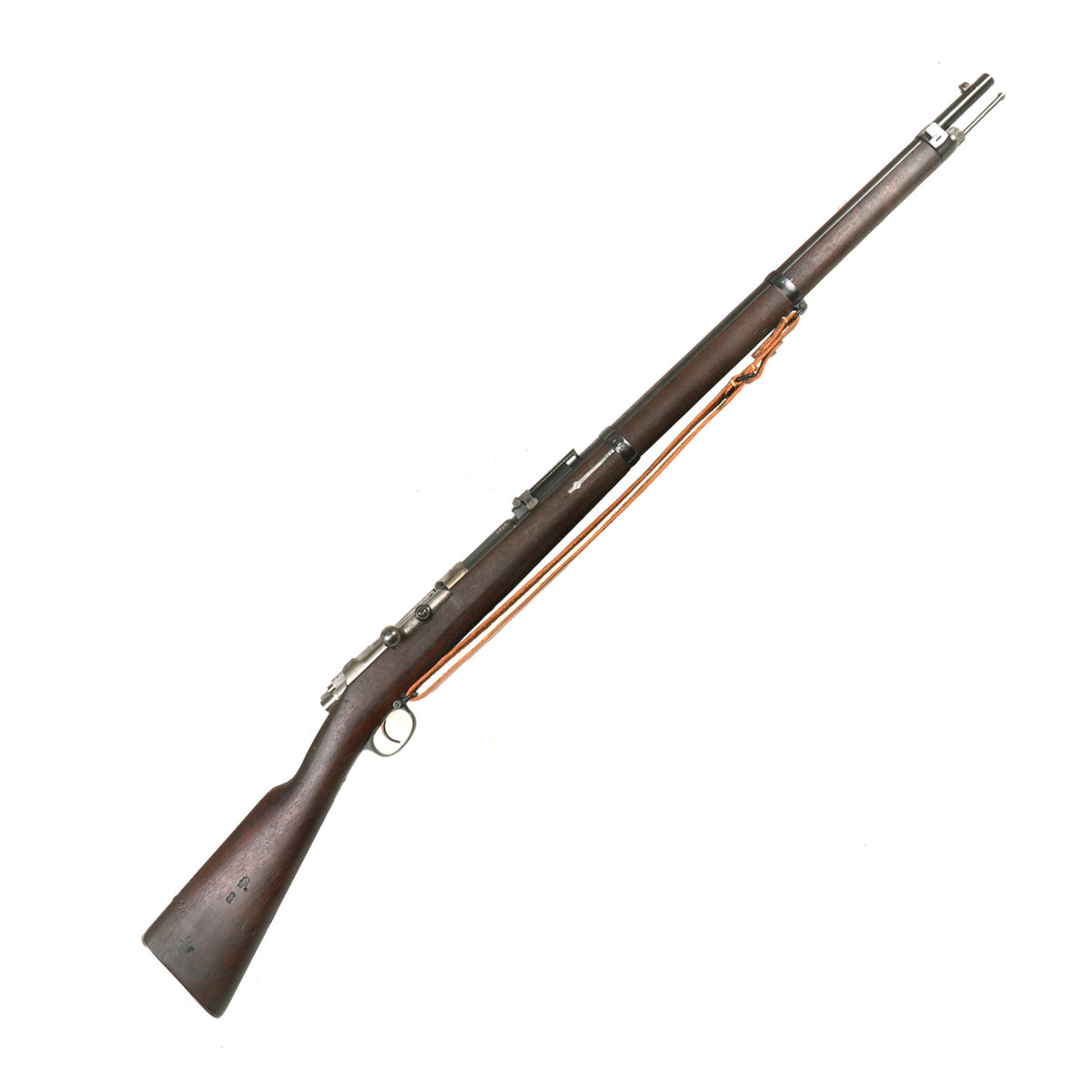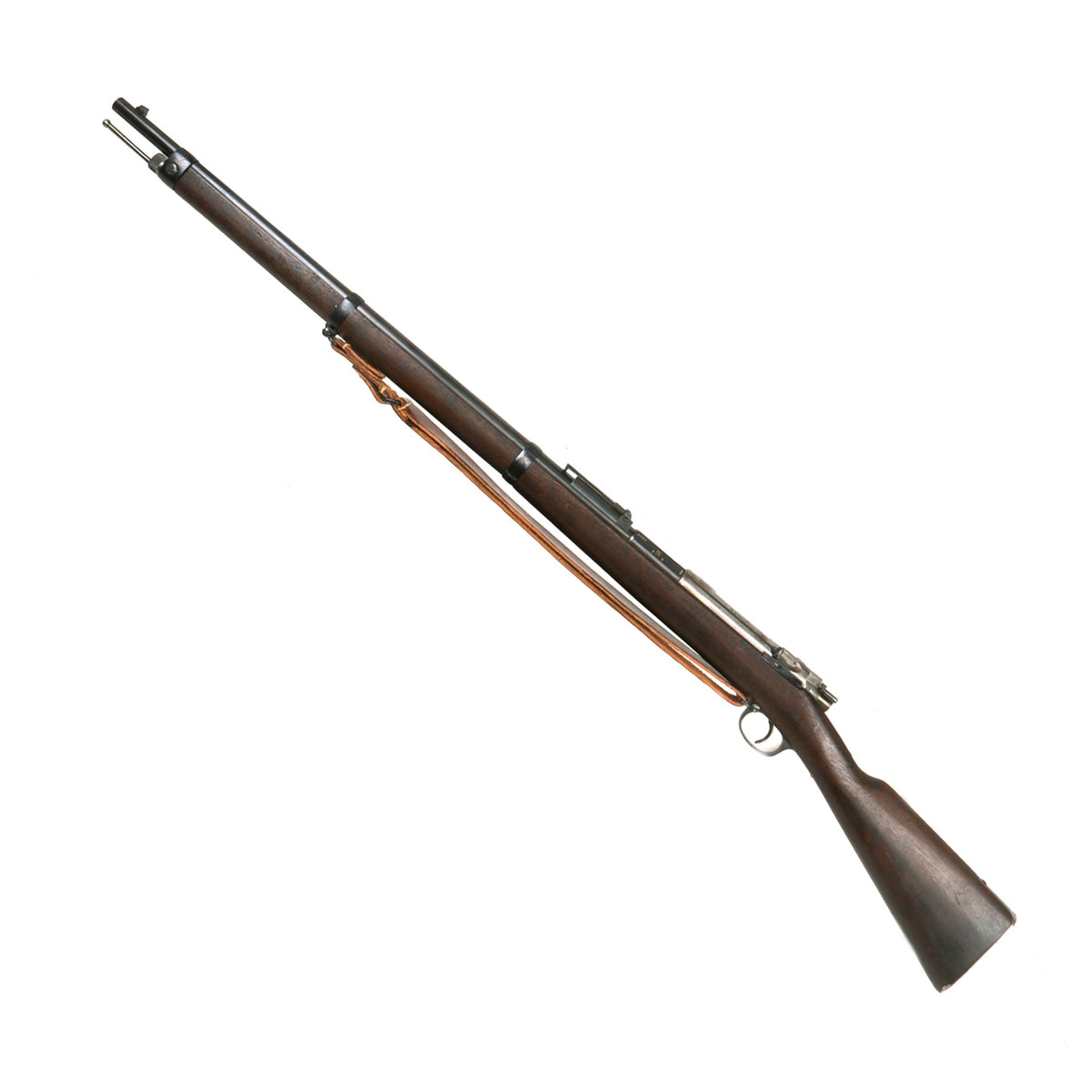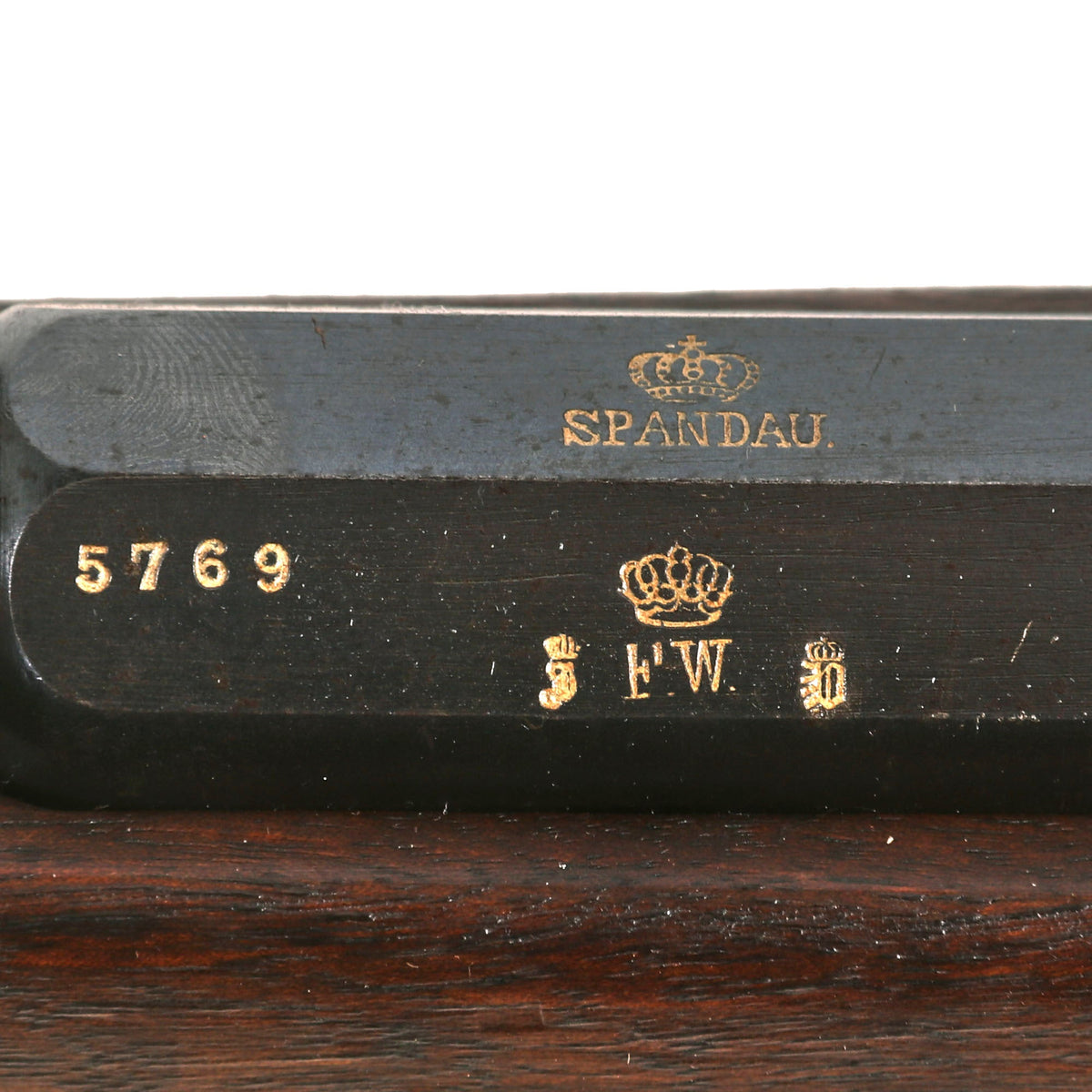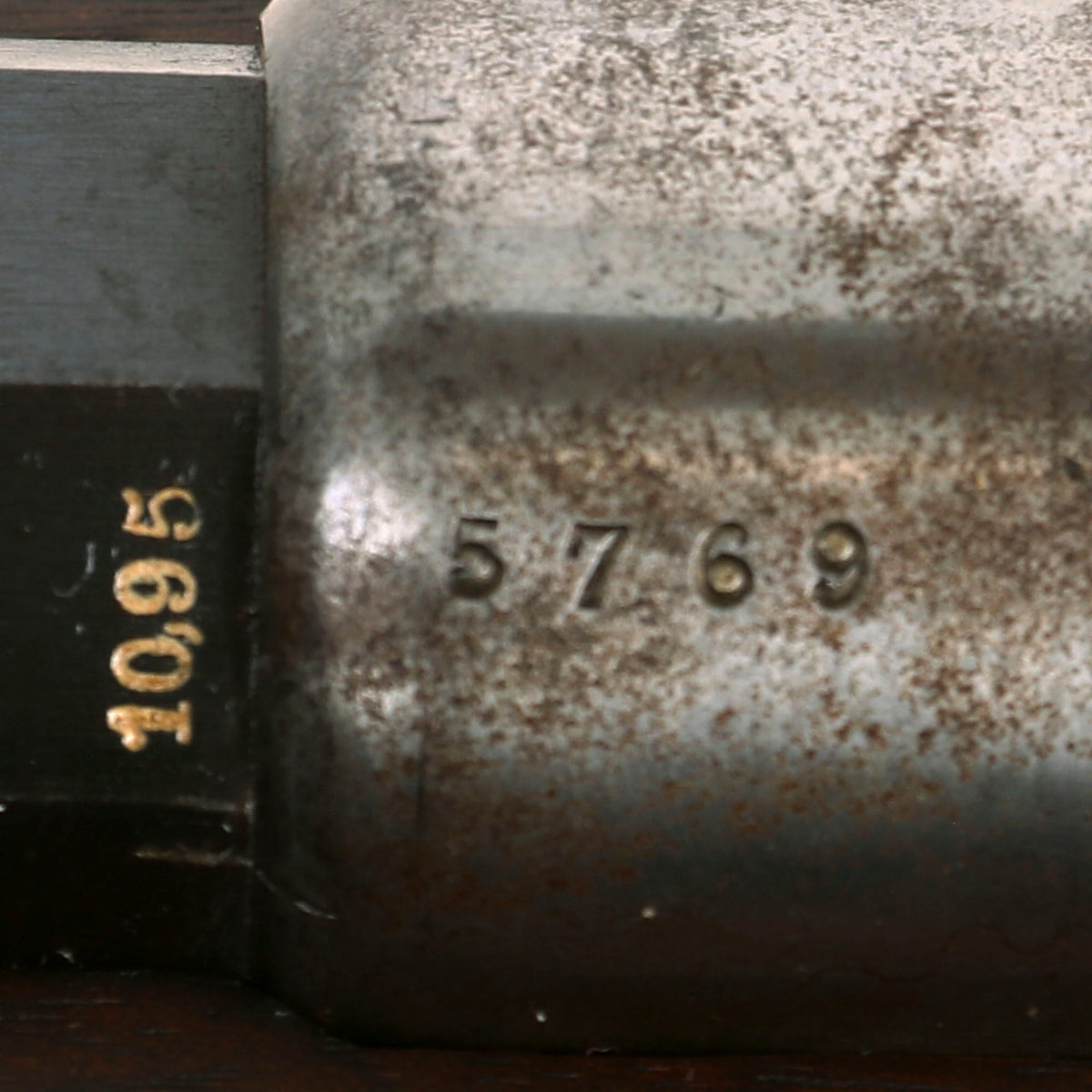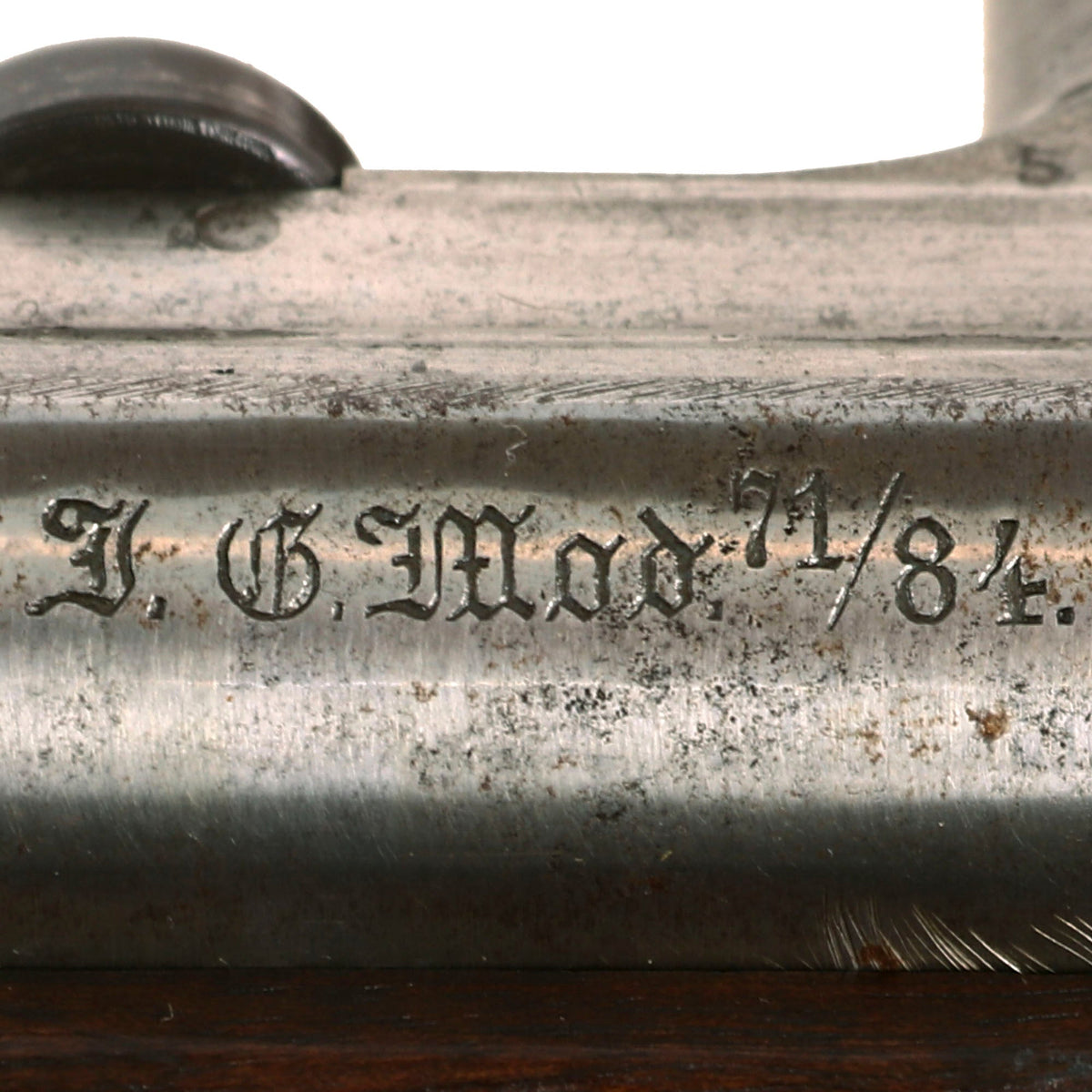Original Excellent Imperial German Mauser Model 1871/84 Magazine Service Rifle by Spandau Dated 1887 – Matching Serial 5769 Original Items
$ 1.995,00 $ 498,75
Original Item: Only One Available. This is an excellent barely used example of the Mauser Model 1871/84 rifle, the first Magazine rifle widely used by the German Empire. While not quite “Museum Grade”, it only shows light storage wear and some staining, and does not appear to have ever been issued. The rifle is covered with Imperial German inspection and acceptance markings, which are still crisp and clear. The serial number 5769 or shortened number 69 appear on almost every component of the rifle, making this a very nice “ALL MATCHING” example. If you were looking for a great example for your collection, this is it!
The receiver is dated 1887. on the right and marked I. G. Mod. 71/84. on the opposite side in “Black Letter” typeface. The rifle is complete with all major parts intact and functional, and almost all of the original finish. The receiver is bright steel with minor staining and surface oxidation, while the barrel and other fittings are a lovely blued finish, with just some light wear in areas. It looks like an unissued gun that was kept in storage for decades, with maybe a wipe down occasionally to keep it clean.
The top of the chamber is marked Crown over SPANDAU, for the Prussian (and later Imperial) Spandau arsenal in Berlin, a storied production plant that would produce weapons up until 1919, including the famous MG08 Maxim. Below this is the Crown over FW proof for Kaiser Wilhelm I, who used this cypher during his reign 1861-1888. Next to this is a 10,95 designation, giving the bore diameter in millimeters.
The butt plate tang of the rifle gives the clear regimental designation K. A. R. R. 257.. Research indicates this would be for the Kaiser Alexander Garde Grenadier Regiment, also known as the “1st (Emperor Alexander) Guards Grenadiers”. Designated in German as the Kaiser Alexander Garde-Grenadier-Regiment Nr. 1, this unit was first raised in 1814 and located in Berlin. The rest of the designation indicates it is for a Reserve unit, weapon 257. Guard regiments were usually staffed by the elite of German society, so it’s not abnormal to find rifles that have seen very little service marked to these regiments.
The bore is in excellent condition, with a bright finish and crisp lands and grooves. It shows little to no signs of ever having been used, and probably qualifies as truly “MINT”. We cannot see any primer ring or other discoloration on the bolt face, so it looks to have not been fired after the original proving at the factory. The action cycles great, with no issues, and the “wing” safety is fully functional. The magazine cutoff is fully functional and the magazine lifter moves well, though we have no way to test it on actual cartridges. The stock has some light dents and scratches from service, however we do not see any signs of use in service, and all of the cartouches are all still crisp and fully legible. It has a lovely dark red brown color, probably from years of being waxed while in storage.
This gun is most likely a WW1 Veteran’s “bring back” souvenir. Great quantities of these 71/84 Rifles were pressed into service in WW1 since great piles of them had been put into storage in 1888 with the introduction of the M-1888 7.92mm German Commission Rifle. It is fitted with a recent production leather sling, which is the correct type.
This is a chance to add a fantastic early Mauser rifle to your collection. Ready to display!
Specifications:-
Year of Manufacture: 1887
Caliber: 11x60mmR Mauser
Cartridge Type: Centerfire Cartridge
Barrel Length: 32 inches
Overall Length: 51 Inches
Action type: Bolt-Action
Feed System: 8 Round Tubular Magazine
Originally adopted as the Gewehr 71 or Infanterie-Gewehr 71, or “Infantry Rifle 71 (“I.G.Mod.71” was stamped on the rifles themselves) this was the first rifle model in a distinguished line designed and manufactured by Paul Mauser and Wilhelm Mauser of the Mauser company, and later mass-produced at Spandau arsenal.
Paul Mauser developed his bolt-action rifle from 1866 to 1871. During 1870-71 trials with many different rifles took place, with the “M1869 Bavarian Werder” being the Mausers’ chief competitor. The Mauser was provisionally adopted on 2 December 1871, pending the development of an appropriate safety. With support from the government’s Spandau arsenal, the improvements to the safety mechanism were completed and the rifle was formally accepted on 14 February 1872 as Infantry Rifle Model 1871 by the German Empire excluding Bavaria. The action was not based on its predecessor, the Dreyse needle gun which had seen service during the Franco-Prussian War of 1870-71, and which was found to have a number of weaknesses.
The now well known Mauser “wing” type safety lever was developed for the Gewehr 71. The Gewehr 71 is a conventional looking bolt action chambered in 11mm using black powder cartridges. The action included only a bolt guide rib as its single locking lug, locking forward of the receiving bridge. The original design was a single-shot. The design was updated in 1884 with an 8-round tubular magazine designed by Alfred von Kropatschek, making this Germany’s first repeating rifle. This version was designated the Gewehr 1871/84. A version of this repeater was adopted by the Ottoman Empire. Designated the M1887, it differentiated from the M71/84 in that it had a side mounted cleaning rod, a second locking lug on the rear of the bolt, and it was in caliber 9.5×60mmR, which Paul Mauser touted as the most efficient (black powder) cartridge. In the early 20th century a few were converted to 7.65×53mm smokeless by the arsenal in Ankara.
NOTE: International orders of antique firearms MUST be shipped using UPS WW Services (courier). USPS Priority Mail international will not accept these. International customers should always consult their country’s antique gun laws prior to ordering.
Fast Shipping with Professional Packaging
Thanks to our longstanding association with UPS FedEx DHL, and other major international carriers, we are able to provide a range of shipping options. Our warehouse staff is expertly trained and will wrap your products according to our exact and precise specifications. Prior to shipping, your goods will be thoroughly examined and securely secured. We ship to thousands clients each day across multiple countries. This shows how we're dedicated to be the largest retailer on the internet. Warehouses and distribution centres can be located throughout Europe as well as the USA.
Note: Orders with more than one item will be assigned a processing date depending on the item.
Before shipping before shipping, we'll conduct a thorough inspection of the items you have ordered. Today, the majority of orders will be delivered within 48 hours. The delivery time will be between 3-7 days.
Returns
The stock is dynamic and we cannot completely manage it because multiple stakeholders are involved, including our factory and warehouse. So the actual stock may alter at any time. It's possible that you may not receive your order once the order has been made.
Our policy is valid for a period of 30 days. If you don't receive the product within 30 days, we are not able to issue a refund or an exchange.
You can only return an item if it is unused and in the same state as the day you received it. You must have the item in its original packaging.
Related products
Uncategorized
Uncategorized
Uncategorized
Uncategorized
Uncategorized
Uncategorized
Angolan Rebel 1970s era 60mm Inert Display Mortar from Angolan Civil War Original Items
Uncategorized
Uncategorized
Band of Brothers ORIGINAL GERMAN WWII Le. F.H. 18 10.5cm ARTILLERY PIECE Original Items
Uncategorized
Uncategorized
Uncategorized
Uncategorized
Uncategorized
Uncategorized
Uncategorized
Uncategorized
Armoured Fighting Vehicles of the World: AFVs of World War One (Hardcover Book) New Made Items
Uncategorized
